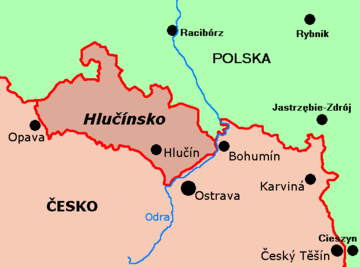Hlučín Region

Hlučín Region (Czech: Hlučínsko (familiarly Prajzsko), German: Hultschiner Ländchen, Polish: Kraik hulczyński) is a part of Czech Silesia in the Moravian-Silesian Region of the Czech Republic, named after the largest town Hlučín. Its area is 316.9 square kilometres (122.4 sq mi), in 2001 was inhabited by 73,914 citizens,[1]
History
Archaeological finds suggest that the area was inhabited since 4500 - 2500 BCE.
The medieval bishoprics of Olomouc and Wrocław both were tried to control it. In the end Olomouc won the dispute and the area became part of the March of Moravia. In 1269 Hlučín belonged to the lands that were split off Moravia by King Ottokar II of Bohemia as the Duchy of Opava, ruled by his illegitimate son Duke Nicholas I. Differences in culture, traditions and economical development from the rest of Moravia grew during the time, mainly caused by Germanisation in the course of the Ostsiedlung. From 1526 onwards the Duchy of Troppau together with the Lands of the Bohemian Crown was part of the Habsburg Monarchy.
The history of Hlučínsko as an entity began with the Treaty of Breslau signed on 11 June 1742 between King Frederick II of Prussia and Empress Maria Theresa of Austria. In 1740 Prussia had started the First Silesian War and conquered most of Silesia. According to the terms of the treaty, the Duchy of Troppau was partitioned: while the lands south of the Opava river remained with Austrian Silesia, the northern part around Hlučín fell to Prussia and was incorporated into the Province of Silesia in 1815.
With Prussia part of the German Empire from 1871 onwards, the area after the German defeat in World War I became the place of an international dispute as it was inhabited by a majority of Czech speaking people. On February 4, 1920 Hlučínsko was handed over without a referendum to Czechoslovakia, according to Art. 83 of the Treaty of Versailles, though surveys suggested that its people felt more as Upper Silesians and, mostly, would have preferred to join the Weimar Republic. Minor border corrections followed in next few years.
On 1 October 1938 Hlučínsko was occupied by Nazi Germany as a part of areas lost by Czechoslovakia in accordance with the Munich Agreement. However, as distinct from other lost Czechoslovakian domains, it was not attached to the Reichsgau Sudetenland but again to the Prussian Province of Silesia (Upper Silesia from 1941). After the Second World War Hlučínsko like the rest of "Sudetenland" returned to Czechoslovakia. In the 1993 dissolution it became part of the Czech Republic.
Municipalities
Towns are shown in bold.
Bělá (Bielau) - Bohuslavice (Buslawitz) - Bolatice (Bolatitz) - Darkovice (Groß Darkowitz) - Dolní Benešov (Beneschau) - Hať (Haatsch) - Hlučín (Hultschin) - Hněvošice (Schreibersdorf) - Chlebičov (Klebsch) - Chuchelná (Kuchelna) - Kobeřice (Köberwitz) - Kozmice (Kosmütz) - Kravaře (Deutsch Krawarn) - Ludgeřovice (Ludgierzowitz) - Markvartovice (Markersdorf) - Oldřišov (Odersch) - Píšť (Pyschcz / Sandau) - Rohov (Rohow) - Služovice (Schlausewitz)- Strahovice (Strandorf) - Sudice (Zauditz) - Šilheřovice (Schillersdorf) - Štěpánkovice (Schepankowitz) - Třebom (Thröm) - Velké Hoštice (Groß Hoschütz) - Vřesina (Wreschin) - Závada (Zawada bei Beneschau)
This municipalities cooperate in micro-region Sdružení obcí Hlučínska since 1992.
To the region used to belong also former municipalities of Malé Hoštice (Klein Hoschütz), now district of Opava, and Hošťálkovice (Hoschialkowitz), Lhotka (Ellguth), Petřkovice (Petershofen), Koblov (Koblau) and Antošovice (Antoschowitz), now districts or parts of Ostrava.
Attractions
Hlučínsko lies between the Beskids (east) and Hrubý Jeseník (west). Opava River flows through Hlučínsko. The area attracts tourists, especially for its cycle trails. There are many historical buildings, unique architecture and folk customs.
Main attractions are:
- natural reservation Dařanec near Vřesina
- castles in Hlučín, Kravaře, Šilheřovice, Dolní Benešov, Velké Hoštice, Chuchelná and Oldřišov
- open-air-museums in Bolatice and Kobeřice
- museum of fortifications in Hlučín
- church buildings in Ludgeřovice, Hněvošice, pilgrimage place in Píšť
- Hlučín lake and other places for swimming
Partner regions
-
 Plateau of the Good Land LAG, Poland
Plateau of the Good Land LAG, Poland
See also
References
- ↑ "Historický lexikon obcí ČR 1869 - 2005 - 1. díl" (PDF) (in Czech). Český statistický úřad. pp. 728 to 735. Retrieved 1 September 2010.
Literature
- Ludmila Hořká: Národopisné paběrky z Hlučínska, (1948)
External links
Coordinates: 49°52′48″N 18°11′35″E / 49.88000°N 18.19306°E
 |
|
|
|
 |
| |
|
| ||
| ||||
| | ||||
| |
|
|